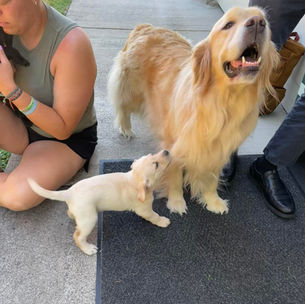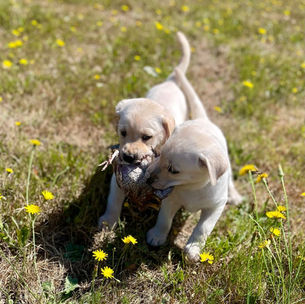
How Joy Luck Lab Puppies Are Raised
The Importance of Early Developmental Stimulation in Puppy Raising

As a physician who specializes in pediatrics, the focus of my profession is on helping newborns develop into healthy adults. In addition to maternal-infant bonding, early enrichment experiences such as socialization and appropriate neurologic stimulation lay the foundation for early brain development, which has been shown to greatly influence a child’s future wellness, learning, and behavior. In the same way, a puppy’s experiences early in life lay down crucial neural pathways that can help them learn faster, acclimate easier, and become more resilient adult dogs. Neuroplasticity is a term used by scientists studying the brain to refer to the brain’s ability to change over time, for better or for worse. Our brains respond to novel stimuli and exercise (or lack thereof) with physical changes including thickening or shrinking grey matter and forging new connections or severing unused connections between nerves. This results in changes to our abilities over time, with those parts of our brains that are more often utilized developing more neurons and faster neural connections. Because of plasticity, enrichment activities such as walks outdoors, exploring novel tactile/visual/acoustic/olfactory sensations, interacting with humans and other animals, and being gently handled increase the pup’s ability to learn and cope successfully with stress later on, thus leading to improved wellness in the adult dog. Of course, genetics combines with environment, exposure, and experience to determine final adult performance. While I endeavor to genetically engineer a superior hunting dog, ongoing socialization and appropriate enrichment and training are necessary to realize the dog’s full adult potential. That’s up to the future owner, but the foundation laid at Joy Luck Labs ensures every puppy will get a head start on the road to greatness. Early Neurological stimulation (ENS) and Early Scent Introduction (ESI) ENS are two specific sets of exercises to which puppies are exposed from days 3-16 to aid their development, resilience and coping mechanisms.
What Is Early Neurological
Stimulation (ENS)

ENS is a practice that has been studied and implemented by breeders and some military canine programs to improve the performance of working dogs. The practice involves a series of brief exercises that apply gentle stressors to stimulate the puppy's endocrine and nervous systems, causing them to develop more ability to deal with stressful events later in life. This may lead to better learning and an improved ability to cope with adversity. Though some of this belief stems from the benefits of ENS shown in other species, it has also been advanced by unpublished work conducted as part of a U.S. Military Working Dog (MWD) training program called “Bio Sensor,” promoted by Dr. Carmen Battaglia. Specific claims on the effects of “Bio Sensor” listed in Battaglia’s discussion include “improved” heart rate, “stronger” heartbeats and adrenal glands, and increased stress tolerance and disease resistance, although how these effects were measured was not specified. However, the effects of short-term, mild stress has been shown to be beneficial in creating “robustness” in the body, preparing it to deal more effectively with stressors later in life. Since Battaglia’s ENS stimulation techniques take little time to do, are low cost, and may provide crucial long term behavioral benefits to dogs, I see only upside in properly performed ENS.
What Is Early Scent Introduction (ESI)

Based on a preliminary survey conducted by Avidog, Dr. Gayle Watkins reported that early scent introduction may result in earlier proficiency in dogsports involving scent, from tracking to hunting, to handler discrimination and nosework. Olfaction is the primary scent by which dogs explore and experience the world, and that olfactory experience begins in the womb, when the puppy’s mother is exposed to scents in her environment. Even before birth, puppies can recognize scent. In one study, researchers fed pregnant bitches food flavored with anise in the last 3 weeks before whelping. When tested within 24 hours after birth, the puppies moved towards the smell of anise. When presented with vanilla, which they weren’t exposed to previously, the attraction was not the same. When puppy’s are exposed to a scent both before birth and after birth, an even stronger preference results. Prenatal exposure might prime the puppy to be more receptive to smells experienced in the womb. That makes sense, given that learning which foods are safe before birth is likely an evolutionary advantage. Further, early exposure to odors increases cell numbers in both the accessory and main olfactory bulb. More cells allow improved olfaction. One researcher commented: “Canines learn odor starting in the prenatal period, due to the influence of maternal diet on the composition of the amniotic fluid, but the learned odor memory appears to dissipate by 10 weeks of age.” Then the puppy’s developing olfactory system takes over. Throughout a canine’s life, olfactory neurons only live for 1-2 months, and unlike other cells, olfactory receptor cells constantly regenerate. But olfactory receptor cells aren’t just replaced with nonspecific cells. The more an animal smells a scent, the more his body responds by producing olfactory receptors for that specific scent. That’s one physiological reason, even once detector dogs are fully trained and deployed in the field, maintenance training is expected to maintain that degree of proficiency. Several studies have shown that dogs develop more olfactory receptors for specific target scents from their detection training. In the same way, dogs we use to locate game birds should be exposed to the scent of game birds early in life. Early neurological development in response to novel stimulation is free and easy. Just a few simple, daily exercises with each puppy in a litter will hopefully accelerate their development and increase their future performance.
Early experiences with a wide range of novel people, places, and things create bold and confident, less reactive dogs.




















